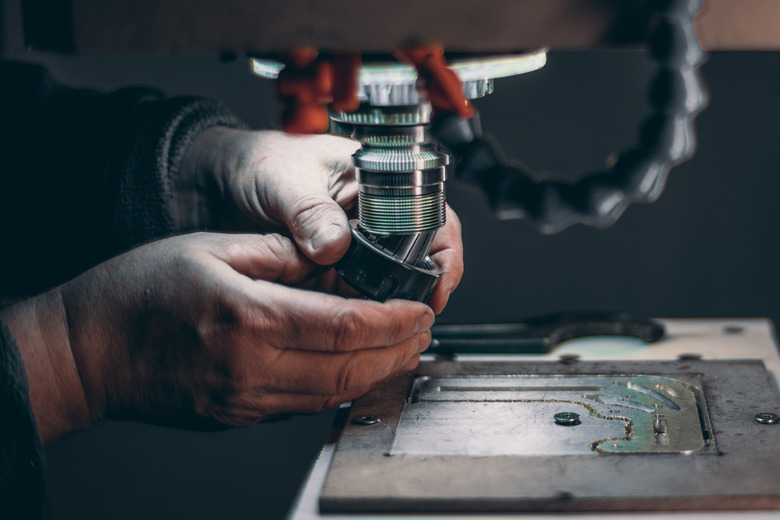How To Convert Mechanical Energy Into Electric Energy
A battery converts chemical energy into electricity, and a solar cell produces electricity from the sun's energy, but if you want to produce electricity from mechanical energy, you need an induction generator. These generators can be small enough to power a crank-style flashlight or large enough to energize entire cities, but all work on the principle of electromagnetic induction, discovered by Michael Faraday, the 19th-century English physicist and inventor. Today, induction generators running on a variety of fuels supply electricity for most of the world's population.
How Induction Works
How Induction Works
Faraday's induction experiment is probably one of the most important in physics, and it was a relatively simple one. He coiled a length of conductive wire around a circular core and connected the wire to a meter. He found that moving a magnet through the center of the circle caused current to flow in the wire. The current stopped when he stopped moving the magnet, and it flowed in the opposite direction when he reversed the direction of the magnet. He later formulated the law of electromagnetic induction, now known as Faraday's Law, which related the strength of the current to the magnitude of the change of the magnetic field, also known as magnetic flux. The strength of the magnet, the number of coils around the core and the characteristics of the conducting wire all influence calculations for real-world generators.
How Generators Use Induction
How Generators Use Induction
Whether located inside a household utility generator, your car or a nuclear power plant, generators generally incorporate the same features. They include a rotor with a hollow core that rotates around a stator. The stator is typically a powerful magnet, while the coils that carry electricity are wound around the rotor. In some generators, the coils are wound around the stator and the rotor is magnetized. It doesn't matter. Either way, electricity will flow.
The rotor has to spin for electricity to flow, and that's where the input of mechanical energy comes in. Large-scale generators tap a variety of fuels and natural processes for this energy. With each rotation of the rotor, the current flow stops, reverses, stops again and returns to the forward direction. This type of electricity is called alternating current, and the number of times it changes direction in a second is an important characteristic.
Types of Fuel
Types of Fuel
The rotor in most generators is connected to a turbine, and in many generating plants, the turbine is steam-driven. Energy is needed to heat water to produce this steam, and that energy can be supplied by fossil fuels, such as coal and natural gas, biomass or nuclear fission. The fuel can also come from natural sources, such as geothermal energy – natural heat emanating from deep in the ground. Hydroelectric generators are powered by the energy of a waterfall. The world's first hydroelectric generator, designed by Nikola Tesla and built by George Westinghouse, is located at Niagara Falls. It generates about 4.9 million kilowatts of power, enough for 3.8 million homes.
Making Your Own Generator
Making Your Own Generator
It's very easy to construct a generator. Many designs are possible, but one of the easiest consists of a stationary coil and a rotating magnet. The wires are wound around a nail coated with insulting tape, and the magnet can be a simple horseshoe-shaped one. When you drill a hole through the base of the magnet, insert a tight-fitting shaft and attach the shaft to a drill, you can generate enough electricity to light a bulb just by operating the drill to make the magnet rotate around the coil.
Cite This Article
MLA
Deziel, Chris. "How To Convert Mechanical Energy Into Electric Energy" sciencing.com, https://www.sciencing.com/convert-mechanical-energy-electric-energy-7561716/. 17 April 2018.
APA
Deziel, Chris. (2018, April 17). How To Convert Mechanical Energy Into Electric Energy. sciencing.com. Retrieved from https://www.sciencing.com/convert-mechanical-energy-electric-energy-7561716/
Chicago
Deziel, Chris. How To Convert Mechanical Energy Into Electric Energy last modified March 24, 2022. https://www.sciencing.com/convert-mechanical-energy-electric-energy-7561716/
